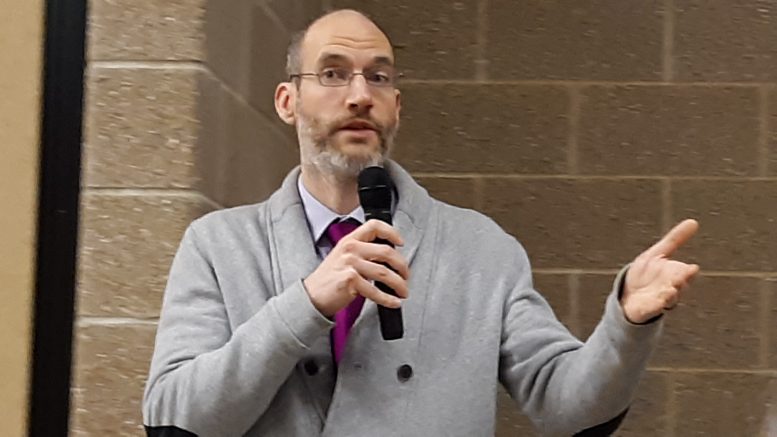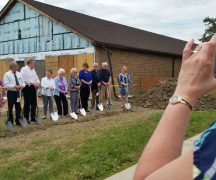By JAN LARSON McLAUGHLIN
BG Independent News
The first Wood County residents testing positive for COVID-19 were announced this afternoon – just as Gov. Mike DeWine was issuing a “stay at home order” for Ohioans.
“Obviously, we’re in unprecedented times,” Wood County Health Commissioner Ben Batey said during a phone press conference at 4:30 p.m.
“We anticipated this day would come,” Batey said of the two Wood County cases. “While we’ve been diligently working on this, this is the confirmation we’ve been waiting for.”
The positive tests were recorded in a couple in their 60s who live in Wood County and recently traveled to Europe.
The couple were already having symptoms prior to their return, so they immediately isolated upon their arrival home. They are currently recovering at home, Batey said.
Wood County is only offering testing to hospital patients and their health care providers, but the couple was able to be tested at a drive-through site at St. Luke’s Hospital.
Batey said he does not know if other passengers on the flight were made aware of the couple’s symptoms and test results. Efforts are being made to trace the couple’s contacts back as far as possible.
“I feel like we caught this pretty early on,” Batey said.
“When they came back, they were already isolated the minute that they returned home,” Batey said. “They were no risk to anyone else.”
“We’ve been diligently following up with them, and they are recovering at home, so no need for hospitalization,” he said.
No additional information about the two Wood County residents will be provided in order to protect their privacy, though a Rossford city official has reportedly released that the couple lives in that community.
It is unknown how many Wood County residents have been tested, however, Batey said the number is not great.
“It’s not to the capacity that the public is generally thinking,” he said.
Initially, the health department and Wood County Hospital had hoped to set up a drive-through testing site. A couple days ago, it was instead announced that tests would be reserved for hospital patients and those treating them.
“It turned out that just wasn’t a reality,” Batey said of the drive-through testing. “That is a challenge for us. A lot of the supplies are just unavailable right now.”
While the U.S. can learn from the experiences in other nations, it has the disadvantage of medical supplies running low.
“A lot of supplies have been used up in other countries,” he said.
Last week, Batey said the COVID-19 pandemic in the U.S. was just beginning. That timeline hasn’t moved much.
“This is absolutely the beginning. We will have more cases,” he said today.
“I think it’s going to be more than a couple weeks that we’re living in a different fashion,” he said.
The positive tests reiterate the recommendations already being made by the health department, Batey said.
“We need people to take action and do what we’ve been asking from a public health perspective,” he said. “Stay at home if at all possible, and avoid being around others.”
People should also continue the practices of handwashing, social distancing and disinfecting surfaces.
The update from Wood County officials came within minutes of an announcement by DeWine that the state is enacting a stay-at-home order as the number of cases in Ohio spiked Sunday to more than 350.
DeWine said the stay-at-home order will start to be enforced after midnight Monday by local health departments and local law enforcement. The order asks residents to stay at home except for essential needs. Businesses will be asked to shut down if possible.
DeWine said the order allows exceptions, such as going to the grocery store, restaurant carryout, going to a park (but not use of playground equipment), taking care of neighbors or family members, weddings and funerals.
“We haven’t faced an enemy like we are facing today in 102 years” since the Spanish flu, DeWine said. “We are at war. In the time of war, we have to make sacrifices.”
Businesses are also being asked to sacrifice.
“He needs a good faith effort from businesses,” Batey said.
“We need folks to use common sense. Are we truly an essential service or not?” he said businesses should be asking.
Businesses that continue operating will be asked to reduce the staff exposed to each other, make sure employees work at least six feet apart, limit customers, and promote disinfecting surfaces and handwashing.
“We will respond to complaints” at businesses, Batey said.
In Wood County, several businesses are closing and governmental offices are working with skeleton staffs.
“We’re seeing businesses shut down,” Batey said.
As for Ohio citizens, it is unlikely that they will be questioned about their travels outside the home.
“I don’t see people being pulled over by law enforcement and questioned if they need to be out and about,” Batey said.
But citizens need to start asking if they truly need to venture out, he said. Stop at one store rather than several, and don’t take the kids, he suggested.
“We need to see streets become quiet to some extent,” he said.
By doing that, public health officials hope to make sure hospital services are available for those who need them the most.
“Staying home is hard because people want to take action,” Batey said.
There are ways people can help, said Wood County Emergency Management Agency Director Jeff Klein.
Many people and organizations are stepping up with donations, Klein said. He asked that people send those medical supplies to the Wood County EMA office, which acts as a clearing house for those who need it most.
Anyone having medical supplies can call the EMA office at 419-354-9269, or email woodcountyema@co.wood.oh.us. Staff from the office will pick up the supplies, Klein said.
A video statement about the cases and what Wood County residents can do to stay safe and help can be seen on the health department’s Facebook page and on YouTube at https://youtu.be/EXZ1XNg4nOE.
Ohio has taken wide actions to prevent the spread of COVID-19 and reduce its impact on the health care system. Orders and guidance from DeWine, along with recommendations from the Ohio Department of Health and local health departments, outline how people should work, attend school and conduct business.
For information on COVID-19 including ways you can prepare and help protect the health of yourself and others, go to www.coronavirus.ohio.gov or call 1-833-4-ASK-ODH (1-833-427-5634). Information and resources are also available from the Centers for Disease Control and Prevention at www.coronavirus.gov.
Symptoms of COVID-19 include fever, dry cough and shortness of breath. Those at greatest risk for severe illness are older people and those with other health problems or compromised immune systems. Although younger people may be less likely to experience severe illness, everyone can get sick with COVID-19 and spread the virus to other people.
If you are sick with COVID-19 or think you might have it, stay home except to seek medical care if necessary. Other people you live with should stay home too.
As much as possible, stay in a specific “sick room” and away from other people in your home. Use a separate bathroom if possible. Do not go to work or school or interact with other people until all of these things are true:
- You have had no fever for 72 hours, without taking medicine that reduces fever.
- Your cough or shortness of breath have improved.
- At least 7 days have passed since your symptoms started.
What can I do?
· Avoid being around people who are sick, and stay home if you are sick.
· Practice social distancing by avoiding crowds and keeping at least 6 feet away from other people as much as possible. Stay at home unless it’s necessary for you to go out.
· Frequently wash your hands with soap and water for at least 20 seconds. Use an alcohol-based hand sanitizer if soap and water are not available.
· Regularly clean and disinfect frequently touched objects and surfaces. This includes counters, tabletops, doorknobs, computer and phone screens, bathroom fixtures, toilets, keyboards, tablets and bedside tables.
· Avoid touching your mouth, nose and eyes. Don’t share food or drinks.
· Cover coughs and sneezes with your arm or a tissue.
· Ask your employer about the possibility of working from home.





